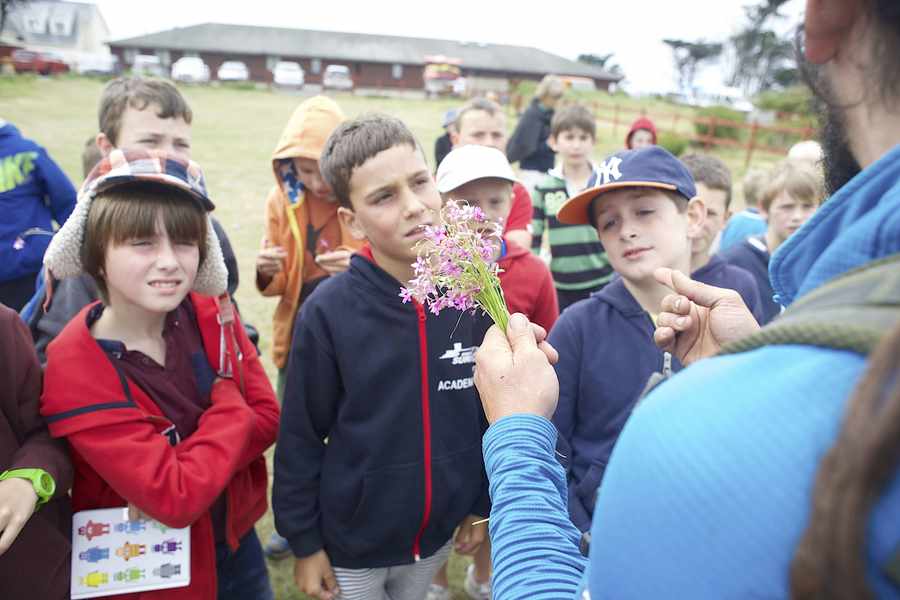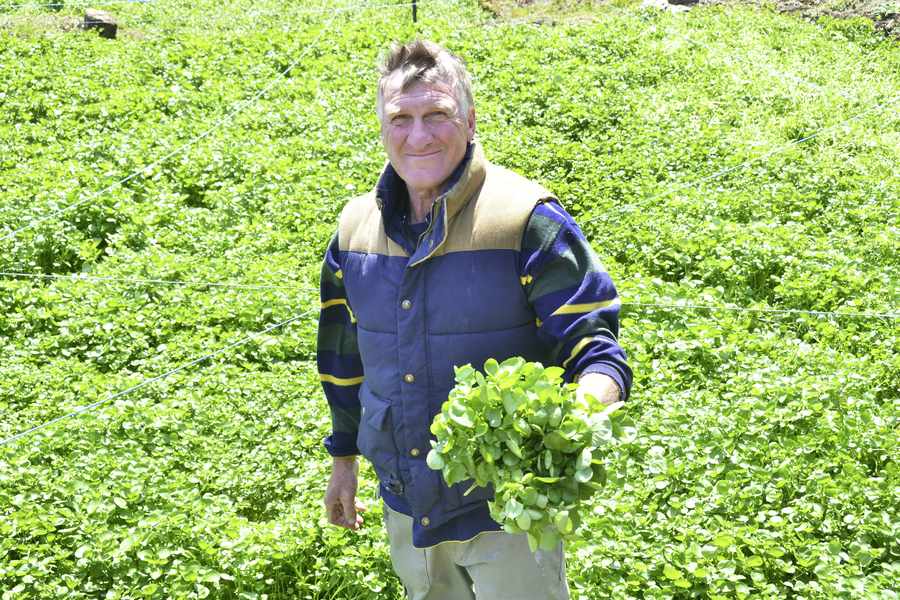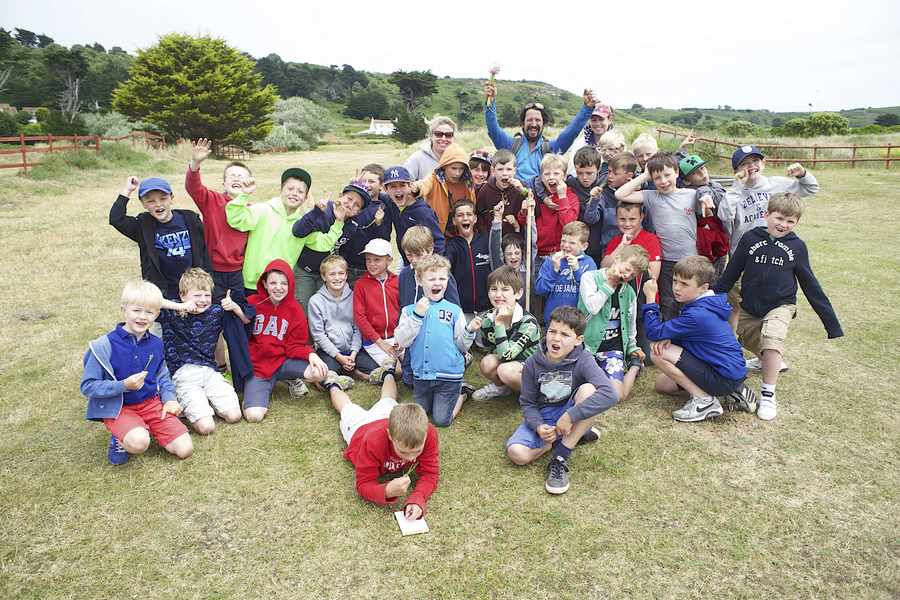- Countryside meets the Bear Grylls of Jersey helping children reconnect with the food chain
- Meet the producers – Jersey’s only watercress farmer
- Comment: Why education is key for the trust
- What’s in season
Island kids on the trail of food and foraging
IT IS a sorry indictment of how far people have become disconnected from the food chain that there are children who believe strawberries grow inside a fridge and carrots come from a bush.
An Islander who has lived in harmony with Jersey’s natural environment since he could walk is on a mission to reconnect us all with the food chain and nature and to teach us, should the need ever arise, how to survive using our wits and ingenuity – or a battery, a chunk of wire wool or the rays of the sun to make fire.
You can’t miss Kazz Padidar. He’s got dreadlocks down to his waist; his dog, Ella, is his permanent shadow; and he’s usually to be found surrounded by a crowd of children inland and at low water in St Ouen’s Bay teaching them how to forage and navigate.
He also give tips on how to detox snails before grilling them with wild garlic.
His activities aren’t just confined to school pupils – about 40 per cent of his business is with adults, and he’s also an early riser to forage for wild plants and herbs for Jersey’s fine-dining establishments. ‘My philosophy is all about reconnecting individuals back to the environment,’ he says.
‘With the kids it is about doing it in the best way and with the right activities, so they can appreciate their surroundings and their own place in the environment.’
To children, like the boys from Victoria College Prep who I tagged along with on a bushcraft trail in Les Mielles during the school’s activities week, he’s Jersey’s answer to adventurer Bear Grylls and a bit of hero.

THE Western Parish Fete is back after the success of the West Show Association’s inaugural event held in St Peter in 2014 – and it’s free.
What promises to be a great day out in the country for families will feature an animal farm, sheep racing and a dog-handling demonstration, live music and dancing and food and drink – including a barbecue of Classic Herd hamburgers and sausages, finished off with the farm’s very own ice cream.
And the JEP’s Jepson the bear will be making a special guest appearance.
In addition to a helter skelter, pirate ship and roundabout, there will be an inflatable football pitch and a magic show.
Inside the horticulture marquee, the Jersey Association of the National Vegetable
Society will be running competitions to find the best beetroot, carrots, runner beans, rhubarb and the funniest-looking vegetable.
The fete takes place at Manor Farm, Rue du Manoir, St Peter, on Saturday 11 July from 10 am to 5 pm.
What is encouraging is that Kazz has a gift of being able to connect with children, making them laugh with corny jokes and keeping their attention – and that is no mean feat when faced with 35 eight- and nine-year-olds.
His trick is to start by showing them, from a safe distance, his collection of knives, which he uses to cut his way through jungles and tropical rainforests when living in the wild.
‘It definitely helps in getting their attention to set the ball rolling,’ he said.
‘That is where children are better in reacting than adults because they are not already stuck in their ways, so there is so much more you can do with them.’
Such as tricks like turning grass stems into ‘pop’ guns, explaining what plants can settle an upset tummy and, a favourite among little boys, that fresh fennel stems will make you break wind, as well as making a compass with water, a bit of metal and a leaf.
He is particularly careful in teaching them about edible plants, so they understand which are poisonous and which one tastes like sour wine gums.
And, apparently, he’s a dab hand at making furry pants – but he has to kill and skin an animal first and that’s not an everyday task when you live, as Kazz does, on the number 12 bus route.

Name: Colin Roche
What do you do? I am the one and only watercress farmer in Jersey
When is your watercress in season? The season starts in March and runs through to Christmas. Watercress is in demand in Jersey, and because the beds are fed by a crystal clear spring with a constant temperature of 10°C even in winter and the beds are covered in the cold months with a special fleece to protect the watercress from frost, I am able to grow for this long and into the winter,
How long have you been growing watercress? I have been in the business for about 35 years, and before that I was a landscape gardener.
Where and how do you grow watercress? My farm is in a meadow in St Martin and the watercress seed (Nasturtium officinale) is specially imported from France. I sow the seeds in compost and then transplant them into the beds, which are made up of sand and gravel, and must have a constant flow of water, from seedling to picking, usually within ten to 12 weeks depending on the weather.
How important is local provenance and freshness to your business? Very important! I don’t export my watercress, as it deteriorates quite quickly when being transported. I pack the watercress in sealed bags for certain businesses – however, some of my customers still prefer it in open bunches.
What makes watercress a ‘super food’? Watercress is packed with vitamins A, B, C and E, is very high in calcium, iron, zinc and folic acid, and has antioxidant properties. It is most potent when eaten fresh and raw. It used to be grown on board naval vessels in the past and it was, and still is, used in the treatment of scurvy.
Should the States give more support to local producers, and why? I have never had any financial support. Like most growers I have had my share of bad luck caused by weather conditions but in the past it seems the States have chosen the lucky few. Speaking for myself, small growers of specialised crops get no help at all.
By Christopher Harris, president of the National Trust for Jersey
THROUGH the generosity of bequests and donations over almost 80 years since our foundation, the National Trust for Jersey has become one of the Island’s most important landowners, with stewardship of some of Jersey’s most beautiful woods, meadows and coastline.
At the National Trust we have a simple belief, strongly held, that a love of the natural world is in every single one of us.
Appreciating nature and understanding it go hand in hand.

That is why we organise a series of educational activities for children of all ages organised by Jo Stansfield, our education officer, none of which would be possible without the support of HSBC.
Our rock-pool rambles are always popular.
One of the most interesting landscapes Jersey has to offer is its seashore; the rock pools and gullies are teeming with wildlife; sea anemones, crabs, darting minnows, brightly coloured seaweeds are all there waiting to be found.
Every Jersey childhood deserves to be spent with days in summer on the beach and what better way than to learn how fish benefit from seaweeds, how limpets eat algae, and how limpets, in turn, get eaten by dog whelks.
Our woodland wanders introduce children to the delights of the Island’s woods, such as those below Hamptonne country life museum.
If they are lucky they may spot a barn owl or birds of prey above the valley and they will be astounded to discover the huge range of insects which live in even a single square metre of leaf floor.
This year we have introduced ‘Tots’ Tales’ – story and activity sessions for children between the ages of two and four.
These brand-new sessions are aimed at pre-school age children with a love of stories and the great outdoors.
Inquisitive tots experience their favourite stories read in natural settings, followed by games and hands-on activities,
in locations such as the meadows by Quétivel Mill in St Peter’s Valley.
Then there are the delights of our Wetlands Centre in St Ouen, just opposite Big Vern’s.
It is a long bird hide, concealed in a sand dune and incorporating a German bunker, that overlooks St Ouen’s Pond and is open throughout the day, giving superb views of the marsh harriers nesting or the migrating birds that stop off in Jersey in the spring and autumn.
Opened in February last year, the centre is popular with primary schools, who make use of the classroom in the bunker, and it is open to the public seven days a week.
No advance booking is necessary and there’s no entry charge, so just drop in, have a stroll on the beach after and end your day with cup of tea and cake at Big Vern’s.

THE Latin name is Fallopia japonica, but it’s commonly known as Japanese knotweed – a large, herbaceous perennial plant native to Japan, China and Korea. Gardeners, environmentalists and insurance companies regard it as a nasty invasive plant that must be eradicated.
Introduced as a garden plant in the 18th century by collectors who travelled the world looking for new and unusual species, it has long broken out of gardens into the rural and urban landscape.
Not only does it spread at an alarming rate, but its roots can go down as deep as two metres and it can penetrate two feet of concrete, so it’s a tough job to get rid of it. Which is why the Environment Department is on a mission to wipe it out, and it needs your help.
At this time of the year it is distinguished by large heart-shaped leaves and a stem that is zig-zagged red and green.
As it is spread by cuttings, you must not strim or flail it as that will simply enable it to spread.
If you spot it, please call the department on 441600 or download the special app plant tracker.






